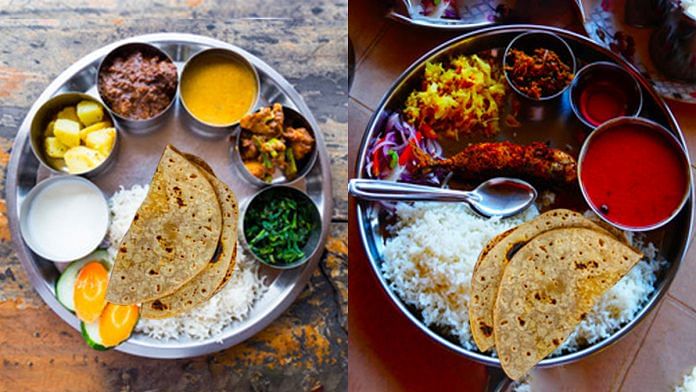New Delhi: The Economic Survey 2019-20 has used “thalinomics” — what a common person pays for a vegetarian or non-vegetarian thali — to defend the Narendra Modi-led BJP government’s inflation management.
Using the annual earnings of an average industrial worker, the survey found that the affordability of vegetarian thalis improved 29 per cent from 2006-07 to 2019-20, while that of non-vegetarian thalis improved by 18 per cent.
In other words, an individual who would have spent around 70 per cent of his/her daily wage on two vegetarian thalis for a household of five in 2006-07 is able to afford the same number of thalis with around 50 per cent of his/her daily wage in 2019 (April-October).
The Economic Survey basically highlights how the Modi government has been successful in reining in inflation compared to its predecessor, the UPA government. At the time the UPA was voted out of power, annual retail inflation was close to double digits.
In 2015, following an amendment to the RBI Act, the government had set an inflation target to contain consumer price inflation to 4 per cent, with a permissible band of plus-minus 2 per cent.
Also read: Economic Survey 2020 projects 6-6.5% growth for Indian economy in next fiscal
Price of vegetables increased during 2019-20
The chapter ‘Thalinomics: The Economics of a Plate of Food in India’ states that the absolute prices of a vegetarian thali have decreased significantly since 2015-16, across India as well as in each of the four regions — north, south, east and west. This has been mainly on account of a significant moderation in the price of vegetables and dal compared to the previous trend of rising prices.
However, the price of a vegetarian thali has increased in 2019 (April-October), mainly due to the increase in prices of vegetables and dal.
“…the increase in the rate of inflation in vegetarian and non-vegetarian thali during 2019-20 is a temporary phenomenon that should revert back as has happened in earlier years,” the survey states.
Also read: 5.5% inflation is transitory, it shouldn’t prevent a fiscal boost in Budget 2020
Jharkhand had most affordable thalis
In 2019 (April-October), the most affordable thali was available in Jharkhand, where two vegetarian thalis for a household of five required about 25 per cent of a worker’s daily wage. The state also had the most affordable non-vegetarian thalis.
Vegetarian thalis have become more affordable in every state under consideration compared to 2006-07, while in the case of non-vegetarian thalis, affordability has increased everywhere except Bihar and Maharashtra, where it has registered a marginal decline.
According to the survey, an average household of five individuals that eats two vegetarian thalis a day gained around Rs 10,887 on average per year, while a non-vegetarian household gained Rs 11,787 on average per year.
The findings are based on an analysis of the prices of a vegetarian and non-vegetarian thali from 2006-07 to October 2019. The survey used price data from the Consumer Price Index for Industrial Workers for around 80 centres in 25 states/UTs from April 2006 to October 2019 for the analysis.
A vegetarian thali has been defined as one that consists of 300g of cereals (rice and wheat), 150g vegetables (potato, onion, tomato, brinjal, cabbage, cauliflower and okra or lady’s finger) and pulses (arhar, gram, moong, masoor and urad).
For a non-vegetarian thali, dal has been replaced by egg, fish and goat meat. The rest of the components remain the same.
Also read: It’s not inflation but economic stagnation that poses a bigger worry for India
‘Thali prices decreased because of reform measures’
The Economic Survey 2019-20 has credited reform measures and initiatives taken by the Modi government for enhancing productivity of agriculture, as well as efficiency of agricultural markets for “better and more transparent price discovery”.
The government launched a slew of schemes such as the Pradhan Mantri Annadata Aay Sanrakshan Abhiyan, Pradhan Mantri Krishi Sinchayee Yojana, Pradhan Mantri Fasal Bima Yojana, Soil Health Card, National Agricultural Market and National Food Security Mission.
“This is reflected in a slowdown in the prices of thalis at the all-India level,” the survey states.
After 2015-16, at the all-India level, there was an average gain of around Rs 3 per vegetarian thali. For each non-vegetarian thali, the average gain was Rs 1.80 in 2016-17, Rs 2.40 in 2017-18, Rs 4.50 in 2018-19 and Rs 4.20 in 2019-20.
‘Partial way of looking at things’
Madan Sabnavis, chief economist at CARE Ratings, told ThePrint that ‘thalinomics’ is a partial way of looking at things.
“The Economic Survey has looked at a certain component for an average vegetarian and non-vegetarian thali. For instance, for a vegetarian thali, prices of pulses and vegetables have come down. Theoretically, one can’t question that,” Sabnavis said.
However, he added that if you look at it holistically, the analysis does not look too convincing.
“It’s not only about the prices of vegetables and pulses. When you cook you need fuel, the cost of which has shot up. Along with it, transportation cost has gone up too. The house in which you are cooking, if it is a rented one, has also seen a price escalation,” Sabnavis said.
Also read: Inflation at 7.3% and growth at 5% — is Indian economy facing stagflation?



